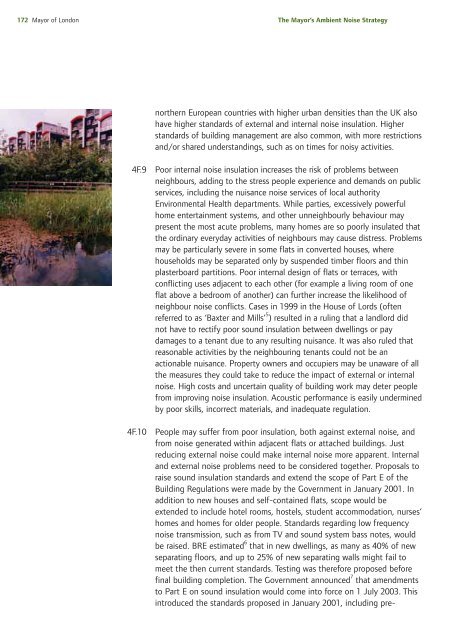The Mayor's Ambient Noise Strategy - Greater London Authority
The Mayor's Ambient Noise Strategy - Greater London Authority
The Mayor's Ambient Noise Strategy - Greater London Authority
You also want an ePaper? Increase the reach of your titles
YUMPU automatically turns print PDFs into web optimized ePapers that Google loves.
172 Mayor of <strong>London</strong><br />
<strong>The</strong> Mayor’s <strong>Ambient</strong> <strong>Noise</strong> <strong>Strategy</strong><br />
northern European countries with higher urban densities than the UK also<br />
have higher standards of external and internal noise insulation. Higher<br />
standards of building management are also common, with more restrictions<br />
and/or shared understandings, such as on times for noisy activities.<br />
4F.9 Poor internal noise insulation increases the risk of problems between<br />
neighbours, adding to the stress people experience and demands on public<br />
services, including the nuisance noise services of local authority<br />
Environmental Health departments. While parties, excessively powerful<br />
home entertainment systems, and other unneighbourly behaviour may<br />
present the most acute problems, many homes are so poorly insulated that<br />
the ordinary everyday activities of neighbours may cause distress. Problems<br />
may be particularly severe in some flats in converted houses, where<br />
households may be separated only by suspended timber floors and thin<br />
plasterboard partitions. Poor internal design of flats or terraces, with<br />
conflicting uses adjacent to each other (for example a living room of one<br />
flat above a bedroom of another) can further increase the likelihood of<br />
neighbour noise conflicts. Cases in 1999 in the House of Lords (often<br />
referred to as ‘Baxter and Mills’ 5 ) resulted in a ruling that a landlord did<br />
not have to rectify poor sound insulation between dwellings or pay<br />
damages to a tenant due to any resulting nuisance. It was also ruled that<br />
reasonable activities by the neighbouring tenants could not be an<br />
actionable nuisance. Property owners and occupiers may be unaware of all<br />
the measures they could take to reduce the impact of external or internal<br />
noise. High costs and uncertain quality of building work may deter people<br />
from improving noise insulation. Acoustic performance is easily undermined<br />
by poor skills, incorrect materials, and inadequate regulation.<br />
4F.10 People may suffer from poor insulation, both against external noise, and<br />
from noise generated within adjacent flats or attached buildings. Just<br />
reducing external noise could make internal noise more apparent. Internal<br />
and external noise problems need to be considered together. Proposals to<br />
raise sound insulation standards and extend the scope of Part E of the<br />
Building Regulations were made by the Government in January 2001. In<br />
addition to new houses and self-contained flats, scope would be<br />
extended to include hotel rooms, hostels, student accommodation, nurses’<br />
homes and homes for older people. Standards regarding low frequency<br />
noise transmission, such as from TV and sound system bass notes, would<br />
be raised. BRE estimated 6 that in new dwellings, as many as 40% of new<br />
separating floors, and up to 25% of new separating walls might fail to<br />
meet the then current standards. Testing was therefore proposed before<br />
final building completion. <strong>The</strong> Government announced 7 that amendments<br />
to Part E on sound insulation would come into force on 1 July 2003. This<br />
introduced the standards proposed in January 2001, including pre-
















